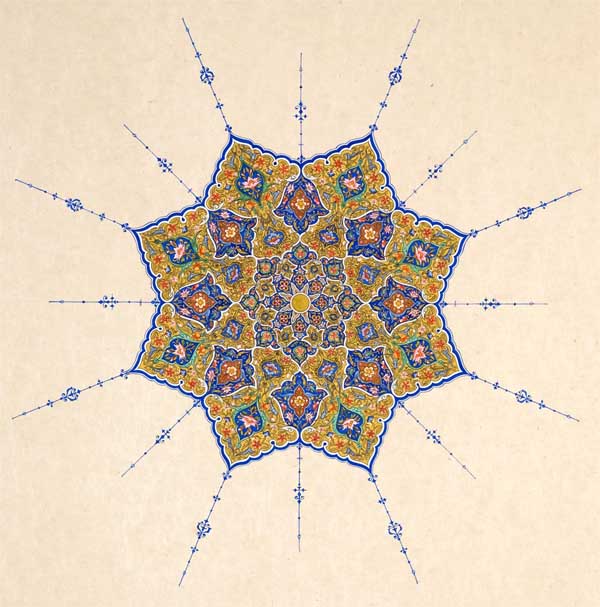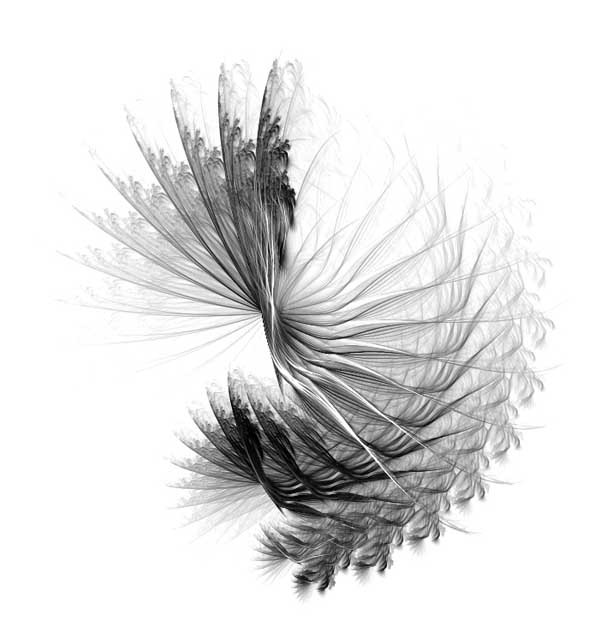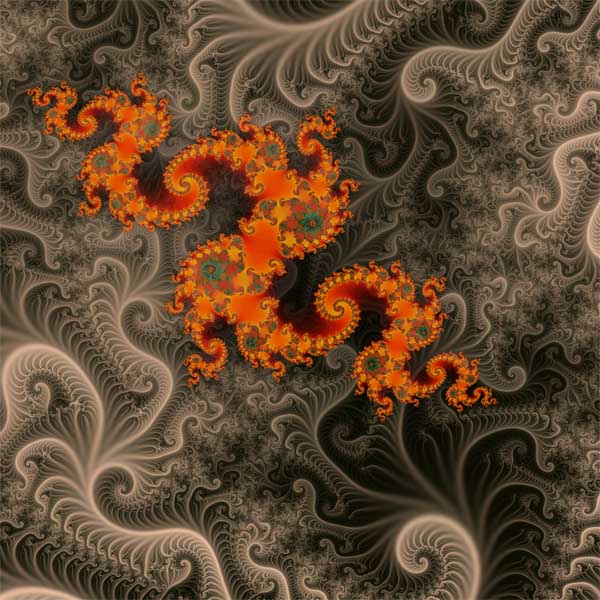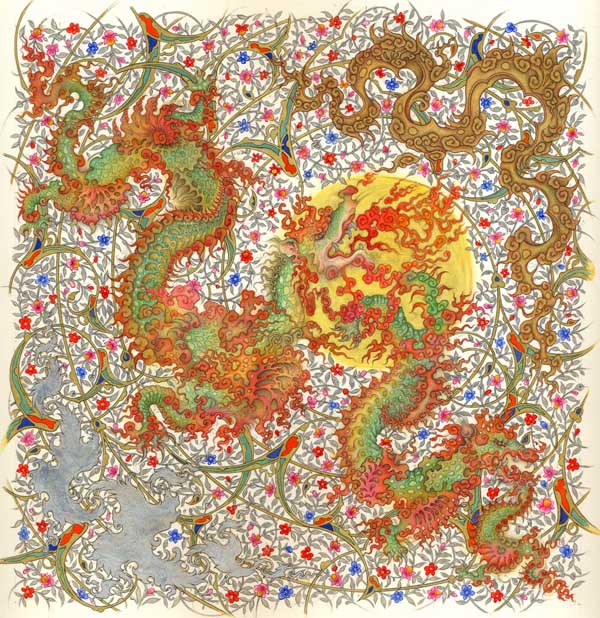Anita Chowdry |
"Illuminated Shamsa"
Gampi paper, hand painted with water based hand ground mineral
pigments and 24 ct. gold, 36cm X 36 cm, 2007.

The word Shamsa derives from the Arabic word for the sun. By the
sixteenth and seventeenth centuries it became a customary device for
the opening pages of royal manuscripts in Safavid Iran and Mughal
India. Traditionally the centre is left as a plain gold disc,
representing the singularity from which all emerges.
The fully rendered shamsa is painted using pigments ground by hand from
metals and minerals. The traditional range of colours used in
illumination derive from the most precious substances, which is why
there is a preponderance of pure gold, silver, lapis lazuli (blue),
cinnabar (red), and malachite (green). This shamsa is based on an
octagonal geometric structure which grows exponentially from the centre,
upon which is superimposed a traditional grammar of stylized natural
designs repeated on different scales - or hand rendered iterated functions.
"Fractal Shamsa"
High quality print of flame fractal construction (Aphophysis
with Photoshop post production), 36cm X 36 cm, 2009.

The circular or star shape of the shamsa is universal, and mirrored in
many natural structures. Fractal geometry is a way of describing
naturalistic forms using repetitive mathematical equations, which build
up complex images based on iterations of similar elements on different
scales. The fractal shamsa drawing was built up using a computer
programme called "Apophysis" which uses random iterated functions. The
illuminator's craft is replaced with the craft of manipulating
coordinates on the complex number plane to create the image.
"Julia Fractal Dragon"
High quality print of Ultra-Fractal image (Julia),19.5 cm X 19.5 cm, 2009.

The sinuous "Ajhda" or dragon of Iranian literature and undulating cloud
patterns that appear extensively in Safavid illumination and marginal
design derive their form from Chinese models. Intriguingly, certain
fractal algorithms throw up similar shapes.
The Julia dragon was constructed using a computer programme called
"Ultra Fractal" and is based on the classic Mandelbrot and Julia
structures modified by a mathematician called Shigehiro Ushiki. The
dragon or cloud shape comes from reiterated elements in exponentially
growing and receding proportion.
"Illuminated Julia Dragon"
Fabriano paper, hand painted with water based hand ground mineral
pigments and 24 ct. gold, 19.5 cm X 19.5 cm, 2009.

Elements that derive from classic illumination and fractal images are
playfully combined in a contemporary illuminated design using
traditional pigments. Against a backdrop of a floral archemedian spiral,
the Ajhda mirror the Julia Fractal below a classic 16th century strap
cloud, a hand drawn silver Julia cavorts along below. Concepts of
calligraphic line, controlled proportion and movement (harkat) are
important in Iranian manuscript painting, and often drawn freehand (as
here) with intuitive, rather than mechanically measured geometry.
Anita Chowdry, professional artist and freelance educator
London, England
Institutions which which I am mostly associated are the School of
Oriental and African srudies, The British Museum and the Victoria and
Albert museum.
Woodstock New York, United States
Anita Chowdry is a painter, researcher and educator. She studied
traditional miniature painting techniques under a hereditary master in
India in the early 1990s. Since then her research has been centered on
the techniques and material preparation used by painters in 16th and
17th century Mughal ateliers, in which she has run dedicated workshops
at major institutions in Britain and abroad.
"The scope of these works is to consider the eclectic nature and
universal impact of Islamic manuscript art, the role of mathematics and
craftsmanship in its making, and to explore ways of extending its
possibilities beyond traditional boundaries by incorporating new media
and techniques.
The focus is on exploring of the art of manuscript illumination, its
underlying geometric structure and repertoire of imagery, and its visual
links with fractal geometry.
These paintings utilize traditional mineral pigments
and techniques of illumination, digital fractal prints and laser-cut
steel installations."